Vehicle registration plates of Ontario
The Canadian province of Ontario first required its residents to register their motor vehicles and display licence plates in 1903. Plates are currently issued by the Ministry of Transportation of Ontario (MTO).
The location of plates and renewal stickers is specified by the Highway Traffic Act[1] and Regulation 628 under the Act.[2]
"Loyal she began, loyal she remains"
The symbol of a crown, representing the Crown of Canada, has appeared on almost all Ontario licence plates since 1937, when it was first used to commemorate the coronation of King George VI and Queen Elizabeth. Exceptions include the 1951 plates, and farm series plates issued in the 1980s and 1990s. Toronto politician and Orange Order leader Leslie Saunders led protests against a proposal to remove the crown in 1948, a decision the government overturned.[3]
Passenger plates 1903 to present
In 1956, the U.S. states and Canadian provinces came to an agreement with the Automobile Manufacturers Association that fixed the size for licence plates for vehicles, except those for motorcycles, at six inches in height by twelve inches in width, with standardized mounting holes. The 1954 (dated 1955) issue was the first Ontario licence plate that complied with these standards.
All Ontario licence plates issued since 1973 are still valid for display today, provided they have been continuously registered.
| Image | Dates issued | Design | Slogan | Serial format | Serials issued | Notes |
|---|---|---|---|---|---|---|
 |
1911 | White on blue porcelain | none | 12345 | 1 to approximately 11500 | |
 |
1912 | Black on off-white | none | 12345 | 1 to approximately 16500 | |
 |
1913 | Black on yellow | none | 12345 | 1 to approximately 24000 | |
 |
1914 | Dark blue on orange | none | 12345 | 1 to approximately 33000 | |
 |
1915 | Dark blue on yellow-green | none | 12345 | 1 to approximately 43000 | |
 |
1916 | Black on white | none | 12345 | 1 to approximately 64000 | |
 |
1917 | Dark blue on white | none | 12345 | 1 to approximately 78000 | |
 |
1918 | Dark blue on off-white | none | 123456 | 1 to approximately 107000 | |
 |
1919 | Black on golden yellow | none | 123456 | 1 to approximately 133000 | |
 |
1920 | Dark green on white | none | 123456 | 1 to approximately 162000 | |
 |
1921 | Orange on royal blue | none | 123-456 | 1 to approximately 184-000 | First embossed plate. |
 |
1922 | Black on gray | none | 123-456 | 1 to approximately 216-000 | |
 |
1923 | Gray on black | none | 123-456 | 1 to approximately 260-000 | |
 |
1924 | Black on light yellow | none | 123-456 | 1 to approximately 313-000 | |
 |
1925 | Orange-yellow on black | none | 123-456 | 1 to approximately 309-000 | |
 |
1926 | Black on gray | none | 123-456 | 1 to approximately 415-000 | |
 |
1927 | Black on buff | none | 123·456 | 1 to approximately 437·000 | First use of the full province name. |
 |
1928 | Black on golden yellow | none | 123·456 | 1 to approximately 446·000 | |
 |
1929 | Black on gray | none | 123·456 | 1 to approximately 477·000 | |
 |
1930 | Black on white | none | A-1234 | A-1 to Z-9999 | Letters G, I and Q not used in serials.[4] |
| AB-123 | AA-1 to approximately PV-999 | |||||
 |
1931 | Black on yellow | none | A·1234 | A·1 to Z·9999 | |
| AB·123 | AA·1 to approximately OT·999 | |||||
 |
1932 | Black on white | none | A·1234 | A·1 to Z·9999 | |
| AB·123 | AA·1 to approximately OB·999 | |||||
 |
1933 | Black on yellow | none | A·1234 | A·1 to Z·9999 | |
| AB·123 | AA·1 to approximately MZ·999 | |||||
 |
1934 | Black on off-white | none | A·1234 | A·1 to Z·9999 | |
| AB·123 | AA·1 to approximately NA·999 | |||||
 |
1935 | Embossed black numbers on orange plate; "19 ONTARIO 35" embossed in black block letters at top | none | A·1234 | A·1 to Z·9999 | |
| AB·123 | AA·1 to approximately OK·999 | |||||
 |
1936 | Embossed white numbers on black plate; "19 ONTARIO 36" embossed in white block letters at bottom | none | A·1234 | A·1 to Z·9999 | |
| AB·123 | AA·1 to approximately PK·999 | |||||
 |
1937 | Embossed white numbers on red plate; "ONTARIO 1937" embossed in white block letters centred at top, with embossed white crowns to left and right | none | 1·A·234 12·A·34 123·A·4 |
First base to feature a crown in any form. | |
 |
1938 | Embossed orange numbers on light blue plate; "ONTARIO" embossed in orange block letters centred at bottom; embossed orange crown centred at top with "19" and "38" to left and right respectively | none | 1A234 12A34 123A4 |
||
 |
1939 | Embossed white numbers on black plate; "ONTARIO" embossed in white block letters centred at bottom; embossed white crown centred at top with "19" and "39" to left and right respectively | none | 1A234 12A34 123A4 A1234 |
||
 |
1940 | Embossed black numbers on yellow plate; embossed black crown centred at top, with "ONTARIO" and "1940" in black block letters to left and right respectively | none | 1A234 12A34 123A4 A1234 |
||
 |
1941 | Embossed green numbers on white plate; embossed green crown centred at top, with "ONTARIO" and "1941" in green block letters to left and right respectively | none | 1A234 12A34 123A4 A1234 |
||
 |
1942 | Embossed black numbers on orange plate; embossed black crown centred at top, with "ONTARIO" and "1942" in black block letters to left and right respectively | none | 1A234 12A34 123A4 A1234 |
||
 |
1943–44 | Embossed orange numbers on black plate; embossed orange crown centred at top, with "ONTARIO" and "1943" in orange block letters to left and right respectively | none | 1A234 12A34 123A4 A1234 |
Revalidated for 1944 with windshield stickers, due to metal conservation for World War II. | |
 |
1945 | Embossed white numbers on blue plate; embossed white crown centred at top, with "ONTARIO" and "1945" in white block letters to left and right respectively | none | 1A234 12A34 123A4 A1234 |
||
 |
1946 | Embossed white numbers on black plate; embossed white crown centred at top, with "ONTARIO" and "1946" in white block letters to left and right respectively | none | 1A234 12A34 123A4 A1234 |
||
 |
1947 | Embossed black numbers on silver plate; embossed black crown centred at top, with "ONTARIO" and "1947" in black block letters to left and right respectively | none | 1A234 12A34 123A4 A1234 |
||
 |
1948 | Embossed white numbers on blue plate; embossed white crown centred at top, with "ONTARIO" and "1948" in white block letters to left and right respectively | none | 1A234 12A34 123A4 A1234 |
||
 |
1949 | Embossed blue numbers on white plate; embossed blue crown centred at top, with "ONTARIO" and "1949" in blue block letters to left and right respectively | none | 1A234 12A34 123A4 A1234 1234A |
||
 |
1950 | Embossed white numbers on black plate; embossed white crown centred at top, with "ONTARIO" and "1950" in white block letters to left and right respectively | none | 1A234 12A34 123A4 A1234 1234A |
||
 |
1951–52 | Embossed blue numbers on white plate; "19–ONTARIO–51" embossed in blue block letters at top | none | 1A234 12A34 123A4 A1234 1234A AB123 |
Revalidated for 1952 with windshield stickers. | |
 |
1953 | Embossed white numbers on blue plate; embossed white crown centred at top, with "ONTARIO" and "1953" in white block letters to left and right respectively | none | 1A234 12A34 123A4 A1234 1234A AB123 |
||
 |
1954 | Embossed blue numbers on white plate; embossed blue crown centred at top, with "ONTARIO" and "1954" in blue block letters to left and right respectively | none | 1A234 12A34 123A4 A1234 1234A AB123 |
||
 |
1955 | As 1953 base, but with "1955" to right of crown | none | 123·456 A12·345 |
First 6" x 12" plate. | |
 |
1956 | As 1954 base, but with "1956" to right of crown | none | 123·456 A·12345 |
||
 |
1957 | Embossed white numbers on black plate; embossed white crown centred at top, with "ONTARIO" and "1957" in white block letters to left and right respectively | none | 123·456 A·12345 |
||
 |
1958 | Embossed black numbers on white plate; embossed black crown centred at top, with "ONTARIO" and "1958" in black block letters to left and right respectively | none | 123·456 A·12345 |
||
 |
1959 | As 1957 base, but with "1959" to right of crown | none | 123·456 A·12345 |
||
 |
1960 | As 1958 base, but with "1960" to right of crown | none | 123·456 A·12345 |
||
 |
1961 | As 1957 base, but with "1961" to right of crown | none | 123·456 A·12345 |
||
 |
1962 | As 1958 base, but with border line, and with "1962" to right of crown | none | 123·456 A·12345 |
||
 |
1963 | As 1957 base, but with border line, and with "1963" to right of crown | none | 123·456 A·12345 |
||
 |
1964 | As 1958 base, but with border line, and with "1964" to right of crown | none | 123·456 A·12345 |
||
 |
1965 | Embossed white numbers on blue plate with border line; embossed white crown centred at top, with "ONTARIO" and "1965" in white block letters to left and right respectively | none | 123·456 A·12345 12345·A |
||
 |
1966 | Embossed blue numbers on white plate with border line; embossed blue crown centred at top, with "ONTARIO" and "1966" in blue block letters to left and right respectively | none | 123·456 A·12345 12345·A |
||
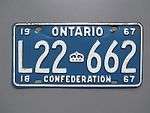 |
1967 | Embossed white numbers and crown separator on blue plate with border line; "ONTARIO" embossed in white block letters centred at top; "19" embossed in top left corner, "18" in bottom left corner and "67" in top right and bottom right corners | "CONFEDERATION" embossed in white block letters centred at bottom | 123-456 A12-345 123-45A |
Issued as part of the Canadian Centennial celebration. | |
 |
1968 | Embossed blue numbers and crown separator on white plate; "1968" and "ONTARIO" embossed in blue block letters centred at top and bottom respectively | none | 123-456 A12-345 123-45A |
||
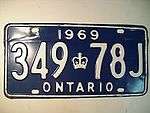 |
1969 | Embossed white numbers and crown separator on blue plate; "1969" and "ONTARIO" embossed in white block letters centred at top and bottom respectively | none | 123-456 A12-345 123-45A |
||
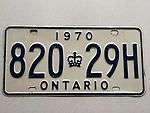 |
1970 | As 1968 base, but with "1970" embossed at top | none | 123-456 A12-345 123-45A |
||
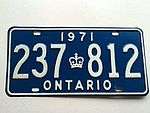 |
1971 | As 1969 base, but with "1971" embossed at top | none | 123-456 A12-345 123-45A |
||
 |
1972 | As 1968 base, but with "1972" embossed at top | none | 123-456 A12-345 123-45A |
||
 |
1973–78 | Embossed blue numbers and crown separator on white plate with border line; "ONTARIO" embossed in blue block letters centred at top; "73" embossed in bottom left corner and full sticker box in bottom right corner | "KEEP IT BEAUTIFUL" embossed in blue block letters centred at bottom | ABC-123 | AAA-001 to NKJ-999 | First multi-year issue. |
 |
1978–82 | As above, but without embossed "73", and with partial sticker box in bottom right corner | NKK-001 to TMA-999 | |||
 |
1982–86 | As above, but with no sticker box | "YOURS TO DISCOVER" embossed in blue block letters centred at bottom | TMB-001 to ZZZ-999 | Staggered registration introduced 1983, with each plate expiring in the same month as the registrant's birthday. | |
 |
1986–94 | 123-ABC | 001-AAA to 999-VYH | |||
 |
1994–97 | Embossed blue numbers and screened blue crown separator on reflective white plate; "ONTARIO" screened in blue serifed letters centred at top | "YOURS TO DISCOVER" screened in blue serifed letters centred at bottom | 123-ABC | 001-VYJ to 999-ZZZ | Narrower dies introduced in preparation for ABCD-123 serial format. |
 |
1997–present | ABCD-123 | AAAA-001 to CCTR-999 (as of July 31, 2017) | |||
 |
2008–present | "TANT À DÉCOUVRIR" screened in blue serifed letters centred at bottom | Extra-cost alternative issue. |
Serial numbers reserved for government officials
| Serial(s) | Political Office of Holder(s) | Level of Government |
|---|---|---|
| CAN-001 | Prime Minister of Canada | Federal |
| CAN-002 to CAN-999 | Federal Cabinet Ministers | Federal |
| SEN-001 to SEN-999 | Members of the Senate | Federal |
| MHC-001 to MHC-999 | Members of the House of Commons | Federal |
| FCJ-001 to FCJ-999 | Federal Court Judges | Federal |
| FDA-001 to FDZ-999 | Federally Owned Vehicles | Federal |
| ONT-001 | Premier of Ontario | Provincial |
| ONT-002 to ONT-999 | Provincial Cabinet Ministers | Provincial |
| MPP-001 to MPP-999 | Members of Provincial Parliament | Provincial |
| SCO-001 to SCO-999 | Ontario Superior Court of Justice | Provincial |
| PJO-001 to PJO-999 | Ontario Provincial Judges | Provincial |
Green vehicle plates
| Image | First issued | Description | Slogan | Serial format | Serials issued | Notes |
|---|---|---|---|---|---|---|
 |
2010 | Green on white with graphic trillium separator | Green Vehicle | GVAB 123 | GVAA 001 to present | Issued to plug-in hybrid electric vehicles and battery electric vehicles. Vehicles with these plates can access HOV lanes on 400-series highways, regardless of the number of passengers in the vehicle, until June 30, 2016.[5] See also: government incentives for plug-in electric vehicles. |
| Véhicule écologique | VEAB 123 | VEAA 001 to present |
Historic Vehicles
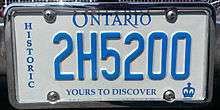
Vehicles more than 30 years old and substantially unchanged since manufacture may qualify for a "Historic" registration.[6]
Annual fees are much lower ($18 vs $108 for a passenger car in 2015)[7] but historic vehicles may not be used as conventional transportation. They legally may only be driven to and from events and parades where the vehicle is on display, to garages for maintenance, etc. Annual renewal stickers are affixed to the rear plate, as with passenger vehicles.
Historic plates are not to be confused with year-of-manufacture plates.[8]
Commercial plates 1980 to present
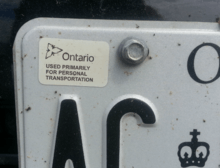
Unlike passenger cars, plate validation stickers are placed on the front plate, instead of the rear.
Ontario vehicles registered in the International Registration Plan receive special commercial plates with "PRP" written vertically on the left. As with other commercial plates, validation stickers are placed on the front plate. All pickup trucks are legally considered commercial vehicles, and thus require commercial plates. However, if used strictly as a passenger vehicle ("personal-use vehicle"), a truck may be exempt from some conditions imposed on commercial vehicles, indicated by a white or red "PERSONAL USE ONLY" sticker affixed in the top left corner of the front plate.[9]
| Image | First issued | Description | Slogan | Serial format | Serials issued | Notes |
|---|---|---|---|---|---|---|
 |
1980 | Black on white with embossed crown separator | none | AB1-234 | AA1-001 to ZD9-999 | Also used for non-passenger personal vehicles (i.e. pick-up trucks and panel vans). |
 |
1995 | Black on reflective white with screened crown separator | Yours to Discover | AB1-234 | ZE1-001 to ZZ9-999 | |
| 1996 | 123-4AB | 100-1AA to 999-9ZZ | ||||
 |
2011 | AB-12345 | AA-10001 to present | On commercial vehicles, license plate stickers are affixed in the top right of the front plate, as shown in the photo. The top left corner may be used for other stickers relating to vehicle use or taxation (i.e.: government exemption). | ||
 |
Tant à Découvrir | DA-10001 to present | ||||
 |
Black on reflective white with screened crown separator "PRP" vertically |
Yours to Discover | Used on vehicles taking part in the International Registration Plan (IRP) |
Farm plates

Vehicles over 3000 kg owned by farmers and used for farm-related purposes, such as the transportation of farm products, working the soil and buildings maintenance, may qualify for a farm plate. Farm-plated trucks and towed trailers may also be used by a farmer for personal transportation.
To qualify, a farmer must meet a series of criteria, including membership in farming organisations and derive a minimum amount of income from farming. Fees for farm plates are substantially lower than for passenger or commercial plates. The Highway Traffic Act also exempts farm vehicles from several requirements imposed on commercial vehicles.[10]
Farm plates are black on white, with a black crown separator, in a pattern similar to commercial plates. They have the word "FARM" written vertically on the left of the plate. Validation stickers are the same as for other vehicles, and are affixed to the front plate, as with commercial plates.
Other non-passenger plates
| Image | First issued | Description | Slogan | Serial format | Notes |
|---|---|---|---|---|---|

|
1994 | White on reflective red with crown separator. | Yours to Discover | 123-CDx - diplomat 123-CCx - consular |
Diplomatic Plate. Ontario plates do not bear indications of the mission. Low numbers assigned to heads of missions (i.e.: ambassadors). |
 |
black on yellow background, with crown separator. | Yours to discover | Dxx-123 | Removable service plate. Before 2007 also used by vehicle dealers. See below. | |
 |
2007 | Red stamped identification on a white reflective background. Screened in black: "DEALER" written vertically on the left, crown separator, "ONTARIO" across the top and "Yours to discover". | Yours to discover | DLx-123 | Removable plate restricted to car dealers. Introduced in 2007 to differentiate dealer's inventory from vehicles being serviced.[12] See below. Issued singly, to be displayed at the back of the vehicle. |
| 2004 | printed on security paper with barcode | 10 Day Temporary Permit/Permis Provisoire de Dix Jours | A-123456 | temporary use only, placed on dashboard at windshield. | |
Trailer plates
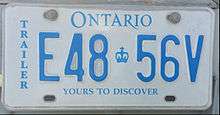
All trailers in Ontario are considered separate vehicles and must have a permit and be plated. New owners of a trailer must register with MTO within six days of purchase. They are then issued with a permit and a plate. Trailer plates are not renewed annually, but may be replaced if lost, damaged or stolen. Plates are affixed to the rear of the trailer. There is no front plate.[13]
All trailers, whether used by commercial operators or others, use a same model plate. Plates are blue on white with crown separator, in a pattern and colour similar to that of passenger vehicles, with the word "TRAILER" written vertically on the left of the plate. However, they do not follow the same numbering system as other vehicles.
General registration licence plates
In Ontario, motor vehicle dealers licensed under the Motor Vehicle Dealers Act use a single portable plate with the word "DEALER" on the left side and red alpha-numeric characters on a white background. It is for exclusive use by motor vehicle dealers only on motor vehicles owned as part of the dealer's inventory of vehicles for sale. It may also be used for private use vehicles that are owned as part of the dealer's inventory of vehicles for sale.[14]
Service providers, including anyone who repairs, customizes, modifies, manufactures or transports motor vehicles or trailers use yellow and black DLR series plates (Dealer and Service Plate).
A service plate may be used:
- on a trailer or motor vehicle other than a motorcycle or motor-assisted bicycle for purposes related to the repair, road testing, customization or modification of the vehicle, if the vehicle is in the possession of the person to whom the service plate is issued, or
- for the purpose of transporting the vehicle by a person engaged in the business of transporting vehicles, or
- for purposes related to the manufacturing or sale of a trailer, or
- for the purpose of towing the vehicle by a person engaged in the business of transporting vehicles, or
- to tow a vehicle to a location where its load will be removed or to an impound facility.
Private use of motor vehicles or trailers with a service plate is not permitted.
Personalized licence plate
Along with regular series plates, the province also offers personalized plates for passenger and commercial vehicles. A personalized licence plate message may contain almost any combination of letters and numbers from two to eight characters. The plates can also include one of 60 different graphics,[15] and two to six characters. Available graphics have changed over the years, with some becoming available, while others have been withdrawn or modified. Owners selecting a graphic but no custom message are generally assigned a registration with a 12XY34 pattern, where the XY is a code indicating the design (i.e.: LN and LM = Loon, CF = Canadian Flag, etc.).
The province reserves the right to refuse or withdraw plates for a variety of reasons,[16] including:
- Sexual messages
- Abusive, obscene language and derogatory slang
- Promotion or denunciation of religion and religious figures
- Promotion of use of drugs or alcohol
- Messages relating to politics, political figures, negative statements on institutions and persons, public personalities, or police badge numbers
- Advocating or promoting violence or crime
- Any discriminatory statement
- Ambiguous or confusing numbers, or which may be mistaken for another existing plate (about 1 in 3 rejections)
- Messages which may infringe on copyright and intellectual property
While criteria have existed since the introduction of personalized plates, accusations of excessive zeal led the McGuinty government to set up a review committee in August 2008. The eight-member committee meets weekly to review submissions. In the first half of 2013, it had rejected 3% of requests.[17] Plates have also been withdrawn after issue.[18]
The ownership of plates with graphic elements associated with particular groups, such as veterans or firefighters, may be restricted and require proof of eligibility.
Personalized plates with two to five characters are also available for motorcycles.
 Ontario personalised plates can have up to eight characters, including letters, numbers and the crown.
Ontario personalised plates can have up to eight characters, including letters, numbers and the crown. The minimum number of characters is two.
The minimum number of characters is two. Personalized licence plate. Note the use of the crown as a character.
Personalized licence plate. Note the use of the crown as a character. Plates with graphics are also available. The variety of graphics includes popular Ontario sports teams, such as the Ottawa Senators.
Plates with graphics are also available. The variety of graphics includes popular Ontario sports teams, such as the Ottawa Senators. Ontario Veteran plate. Applicants must confirm their eligibility through the Royal Canadian Legion. Numbers are assigned in 1V2345 format if no personalized message selected.
Ontario Veteran plate. Applicants must confirm their eligibility through the Royal Canadian Legion. Numbers are assigned in 1V2345 format if no personalized message selected. Some money from the sale of the Yellow Ribbon plates such as this one is donated by the province to the Canadian Forces Personnel Assistance Fund to assist Canadian military veterans.[19] The message here is not customized and so the registration has been assigned. The "yellow ribbon" design is indicated by the "YR" code.
Some money from the sale of the Yellow Ribbon plates such as this one is donated by the province to the Canadian Forces Personnel Assistance Fund to assist Canadian military veterans.[19] The message here is not customized and so the registration has been assigned. The "yellow ribbon" design is indicated by the "YR" code. Plate with both a graphic element and a personalised registration. This example bears the logo of the University of Waterloo. Note that the dark areas around the digits are dirt, and not part of the design.
Plate with both a graphic element and a personalised registration. This example bears the logo of the University of Waterloo. Note that the dark areas around the digits are dirt, and not part of the design. Personalized plate bearing the image of the Franco-Ontarian flag ("FL" code). The marketing legend reads "Tant à découvrir", in French.
Personalized plate bearing the image of the Franco-Ontarian flag ("FL" code). The marketing legend reads "Tant à découvrir", in French. Personalized plate bearing the image of the Franco-Ontarian flag. Uncommonly for this pattern, the marketing legend is in English.
Personalized plate bearing the image of the Franco-Ontarian flag. Uncommonly for this pattern, the marketing legend is in English. Personalized plate (front) attached to a pickup truck. Note that as a pickup truck it should otherwise bear a black on white commercial plate, but the personalized plate is blue on white. Validation and "personal use" tags are affixed to the front plate, as in the case of other pickups.
Personalized plate (front) attached to a pickup truck. Note that as a pickup truck it should otherwise bear a black on white commercial plate, but the personalized plate is blue on white. Validation and "personal use" tags are affixed to the front plate, as in the case of other pickups. This personalised rear plate bears a temporary licence plate sticker. Temporary registration allows a "fit" and insured vehicle to be driven for ten days pending completion of the requirements for a regular registration.
This personalised rear plate bears a temporary licence plate sticker. Temporary registration allows a "fit" and insured vehicle to be driven for ten days pending completion of the requirements for a regular registration.
Manufacturing

Since 1991, all Ontario plates have been manufactured for the MTO by Trilcor Industries, owned by the province's Ministry of Community Safety and Correctional Services,[20] at the Central East Correctional Centre in Lindsay, Ontario.[21]
Defective Plates
In 2012, reports began to appear of plates deteriorating earlier than otherwise expected. The reflective layers detached themselves from the metal plate, making the plate unreadable. Approximately 1% of license plates issued have this defect. The defect has appeared in both front and rear plates. Trilcor Industries and the MTO offer a five-year warranty on plates and will replace the defective plates at no cost.[22] Plate replacement for other reasons (theft, damage, wear, etc.) is done at a cost.
Conventional plates can be replaced "over-the-counter" at a license office, but the complete process for personalized plates takes over six months.[23]
Driving with an illegible plate is an offence punishable by fine, under the Highway Traffic Act.[24]
Investigation into causes
In 2015, the Ministry of Community Safety and Correctional Services hired Canada's National Research Council to identify the root cause of licence plate de-lamination. The NRC's report indicated that the reflective material adhered poorly to the aluminium plates, and that embossing process stressed the materials to the point that the reflective layer would puncture and de-laminate. At that point, water and other contaminants could slip between the layers. Also, road de-icing materials contributed to the de-lamination. The report found that this problem was present in samples from all types of plates, except for motorcycle plates.
The report recommended that Trilcor work with its supplier of laminating layer to resolve the problem, and indicated that a thicker layer of material would likely perform better.[25]
- Example of early deterioration of front Ontario Number Plate
- Early deterioration on a rear plate. The aluminum base is visible where the reflective layer has fallen off.
 Close-up view of early damage to a front licence plate of an Ontario car. The reflective layer can be seen de-laminating and separating from the metal base.
Close-up view of early damage to a front licence plate of an Ontario car. The reflective layer can be seen de-laminating and separating from the metal base. Close-up view of similar damage to the rear plate of the same car, indicating this problem is not confined to the front plates.
Close-up view of similar damage to the rear plate of the same car, indicating this problem is not confined to the front plates. For comparison purposes, corrosion on this plate is due to age and wear, rather than a defective substrate.
For comparison purposes, corrosion on this plate is due to age and wear, rather than a defective substrate.
Alternative supplier
In 2016, an increase in the rate of defective plates combined with an increase in the number of registered vehicles led to the Ontario Ministry of Transport unable to keep up with demand for plates. It placed an order for 100,000 units from the Waldale Irwin Holdson Group, the largest licence plate manufacturer in North America.[26] Plates are produced by the Waldale Manufacturing facility in Amherst, Nova Scotia.
Plates from the first batch of 35,000 can be identified due to the use of embossed letters and numbers from Nova Scotia plates, which differ in appearance from Ontarian fonts.[27]
See also
References
- ↑ "Highway Traffic Act, R.S.O. 1990, c. H.8". Government of Ontario. Retrieved 17 September 2015.
- ↑ "R.R.O. 1990, Reg. 628: Vehicle Permits". Government of Ontario. Retrieved 17 September 2015.
- ↑ Leslie Howard Saunders. An Orangeman in public life: the memoirs of Leslie Howard Saunders. Britannia Printers, 1980 pg. 97
- ↑ "Ontario License Plates". allaboutlicenseplates.com. Retrieved July 10, 2017.
- ↑ "Ontario's Green Licence Plate Program". Ministry of Transportation of Ontario. Retrieved 6 July 2015.
- ↑ "Highway Traffic Act, R.S.O. 1990, CHAPTER H.8, s7". eLaws. Queen's Printer for Ontario. Retrieved 17 September 2015.
- ↑ "Fees for other types of vehicles". Ministry of Transportation of Ontario. Queen's Printer for Ontario. Retrieved 17 September 2015.
- ↑ "Vehicles must be 30 years old for historic plate designation". wheels.ca. Toronto Star Newspapers and Metroland news. Retrieved 17 September 2015.
- ↑ "Is my pickup truck a commercial motor vehicle and does it need a CVOR?". Ministry of Transport of Ontario. QUEEN'S PRINTER FOR ONTARIO. Retrieved 31 August 2015.
- ↑ "Register a farm vehicle (permit, licence plate and sticker)". Ministry of Transport of Ontario. Queen's Printer for Ontario. Retrieved 17 September 2015.
- ↑ Used for example by Palestine or Taiwan, which has a trade office but is not officially recognized by the Canadian Government
- ↑ "Dealer plates and Service plates - public information package" (PDF). Hamilton Police. Hamilton Police. Retrieved 24 August 2015.
- ↑ "Driver's Handbook". Ministry of Transportation of Ontario. Queen's Printer for Ontario. Retrieved 17 September 2015.
- ↑ "Frequently Asked Questions about Ontario Dealer Plates". ucda.org. The Used Car Dealers Association of Ontario. Retrieved 24 August 2015.
- ↑ "Choose a licence plate graphic". Service Ontario. Queen's Printer for Ontario. Retrieved 24 August 2015.
- ↑ "Choose an appropriate personalized message". Service Ontario. Queen's printer for Ontario. Retrieved 24 August 2015.
- ↑ Ellison, Marc (2 August 2013). "0UTLAW3D: The vanity licence plates the Ontario government won’t let you see". The Toronto Star. Toronto Star Newspapers Ltd. Retrieved 7 October 2015.
- ↑ Laroque, Corey (10 May 2011). "Government revokes driver's 'WTF' plate". The Toronto Sun. Sun Media. Retrieved 24 August 2015.
- ↑ Leslie, Keith (13 November 2009). "Licence plates to honour troops called 'offensive gimmick'". The Globe and Mail. The Globe and Mail Inc. Retrieved 26 August 2015.
- ↑ "Treatment Programs;Trilcor Industries". Ministry of Community Safety and Correctional Services. Queen's Printer for Ontario. Retrieved 24 August 2015.
- ↑ "First look at where Ontario inmates make blankets, licence plates". CTV News London. CTV Television Network. Retrieved 24 August 2015.
- ↑ Warren, May (22 January 2015). "Peeling licence plates a problem across Ontario". Waterloo Region Record. Metroland News. Retrieved 2 September 2015.
- ↑ "How can I replace a lost, stolen, or damaged licence plate or personalized licence plate?". Service Ontario. Queen's Printer for Ontario. Retrieved 2 September 2015.
- ↑ "Highway Traffic Act (Highway Traffic Act, R.S.O. 1990, c. H.8)". ontario.ca. Queen's Printer for Ontario. Retrieved 2 September 2015.
- ↑ Howorun, Christina (22 September 2016). "Thousands of Ontario licence plates deemed defective". Rogers Digital Media. City News. Retrieved 18 January 2017.
- ↑ "About us". Waldale Irwin Hodson Group. Retrieved 18 January 2017.
- ↑ "Ontario special orders licence plates to meet high demand". CBC News. Canadian Broadcasting Corporation. Retrieved 18 January 2017.
External links
- R.R.O. 1990, Regulation 628 which prescribes vehicle registration
- Highway Traffic Act, R.S.O. 1990, c. H.8
- Ontario licence plates 1969-present
- Joseph P. Sallmen. "ONTARIO License Plate History". Canplates. Archived from the original on 24 November 2001. Retrieved 3 August 2015.
